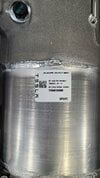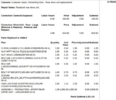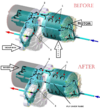I am a 2012 P85 owner that recently proactively replaced my rear drive unit (RDU)/large drive unit (LDU) with the new - released in the Fall of 2023 -Tesla "U" version seal manifold delete/coolant delete. Proactively replacing RDU/LDU
Although I opted for a new (not reman) Tesla replacement, I learned a lot from online research and myriad discussions with 3rd party repair professionals. Here's how I understand the current state of affairs.
Early Model S's are prone to coolant leakage from within the RDU/LDU via the bearing gaskets located in the rotor. Leakage left unchecked could lead to RDU/LDU failure. Options are as follows:
1. Do nothing and don't worry about it. Either you're ok for a long time or you'll start getting alerts tommorrow.
2. Check your speed sensor for coolant.
Then either go back to option 1 or continue to the following options.
3. Replace RDU/LDU as I did.
4. Opt for a new innovation that is often called rotor coolant delete by 3rd parties or seal manifold delete by Telsa. This innovation is a device that blocks incoming coolant from reaching the rotor and "bypasses" directly to the stator, gear box, and inverter. Some 3rd party devices require RDU/LDU removal and some do not. See "Before/After" pic.
a. There are currently three types of rotor coolant delete options.
(1) Tesla's U version. $6k new, $5200 reman. See invoice and RDU/LDU pic. How Tesla's version works is unknown.
(2) 3rd Party after market devices that blocks coolant into rotor while still allowing coolant into stator, gear box and inverter. See "Before/After" pic.
(3) 3rd Party that also blocks coolant into rotor AND eliminates the "flyover pipe" reducing coolant flow into gear box. Some coolant that returns from inverter still goes to the gear box. See "Before/After" pic.
5. Another solution is to drill weep holes into bottom of RDU/LDU. Spirited discussion here. Weep Hole Weep hole +/- in previous spirited link discussion.
Note. If you already have coolant leakage then simply slapping on a coolant delete device and/or weep hole will not fix any existing coolant leakage damage issues, especially if leaking coolant has made it to the inverter. You'll need to address any current cooling leakage damage issues first.
During my research I gathered several opinions regarding the coolant delete method.
1. By bypassing rotor cooling, the rotor and associated bearings will get hotter than pre-coolant delete, simply due to no coolant being applied. However, some point out that the copper rotor has a 2000 degree F melting point and associated bearings also have a high temp tolerance. It's generally agreed that coolant delete is OK unless one is frequently drag racing or towing. Appears to be what will fail first - rotor/bearings with coolant delete option, or coolant damage with status quo.
2. Coolant delete option above that also eliminates the "flyover pipe" reducing coolant flow into gear box could lead to an air pocket forming in the gear box. Note: Tesla U version retains the "fly over pipe".
Thank you for your time.
Although I opted for a new (not reman) Tesla replacement, I learned a lot from online research and myriad discussions with 3rd party repair professionals. Here's how I understand the current state of affairs.
Early Model S's are prone to coolant leakage from within the RDU/LDU via the bearing gaskets located in the rotor. Leakage left unchecked could lead to RDU/LDU failure. Options are as follows:
1. Do nothing and don't worry about it. Either you're ok for a long time or you'll start getting alerts tommorrow.
2. Check your speed sensor for coolant.
3. Replace RDU/LDU as I did.
4. Opt for a new innovation that is often called rotor coolant delete by 3rd parties or seal manifold delete by Telsa. This innovation is a device that blocks incoming coolant from reaching the rotor and "bypasses" directly to the stator, gear box, and inverter. Some 3rd party devices require RDU/LDU removal and some do not. See "Before/After" pic.
a. There are currently three types of rotor coolant delete options.
(1) Tesla's U version. $6k new, $5200 reman. See invoice and RDU/LDU pic. How Tesla's version works is unknown.
(2) 3rd Party after market devices that blocks coolant into rotor while still allowing coolant into stator, gear box and inverter. See "Before/After" pic.
(3) 3rd Party that also blocks coolant into rotor AND eliminates the "flyover pipe" reducing coolant flow into gear box. Some coolant that returns from inverter still goes to the gear box. See "Before/After" pic.
5. Another solution is to drill weep holes into bottom of RDU/LDU. Spirited discussion here. Weep Hole Weep hole +/- in previous spirited link discussion.
Note. If you already have coolant leakage then simply slapping on a coolant delete device and/or weep hole will not fix any existing coolant leakage damage issues, especially if leaking coolant has made it to the inverter. You'll need to address any current cooling leakage damage issues first.
During my research I gathered several opinions regarding the coolant delete method.
1. By bypassing rotor cooling, the rotor and associated bearings will get hotter than pre-coolant delete, simply due to no coolant being applied. However, some point out that the copper rotor has a 2000 degree F melting point and associated bearings also have a high temp tolerance. It's generally agreed that coolant delete is OK unless one is frequently drag racing or towing. Appears to be what will fail first - rotor/bearings with coolant delete option, or coolant damage with status quo.
2. Coolant delete option above that also eliminates the "flyover pipe" reducing coolant flow into gear box could lead to an air pocket forming in the gear box. Note: Tesla U version retains the "fly over pipe".
Thank you for your time.
Attachments
Last edited:






